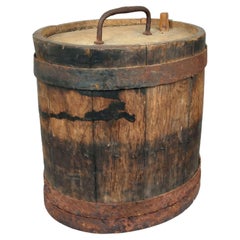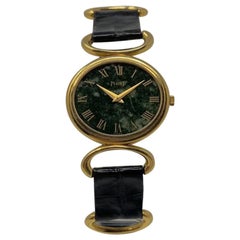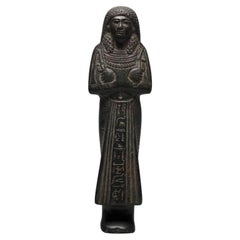Granite Antiquities
2
to
1
1
2
2
2
1
1
1
1,241
433
428
86
78
1
1
1
Material: Granite
Megalithic Stela
Located in London, GB
A tall anthropomorphic stele of carved granite, divided into two distinct regions of the body and face. The body is a single unarticulated block, but the facial features are outlined...
Category
15th Century and Earlier European Antique Granite Antiquities
Materials
Granite
Unusual Tramp Art / Folk Art Wood and Stone Clock, sculpture. cabinet.
Located in Buffalo, NY
Unusual Tramp Art / Folk Art Wood and Stone (granite) Clock, sculpture. cabinet.. Amazing decorative item.Antique hand crafted,Stone ,granite cylinders,
Category
1890s American Folk Art Antique Granite Antiquities
Materials
Stone, Granite
Related Items
Scandinavian Folk Art Wine, Alcohol Oak Cask, 19th Century
Located in Bochum, NRW
19th century Scandinavian wooden cask made of oak staves that are held together with iron banding.
Wonderful piece to add to your collection of Folk Art, early Scandinavian farm pr...
Category
1850s Swedish Folk Art Antique Granite Antiquities
Materials
Iron
1970s Piaget Lady Watch in Gold and Jade
Located in Milan, IT
1970s Piaget lady gold watch, with the face watch in Jade, with original watch strap in alligator signed by Piaget.
In excellent condition, it works p...
Category
1970s Swiss Modern Vintage Granite Antiquities
Materials
Jade, Gold
19th c. American Folk Tramp Art Crown of Thorns Cross in a Large Scale
Located in Savannah, GA
This late 19th century large scale American Folk "Tramp" Art double sided "Crown of Thorns" cross is made up of thousands of carved and joined pieces, held together with the joinery ...
Category
1890s American Folk Art Antique Granite Antiquities
Materials
Wood
H 26.5 in W 13.75 in D 11.5 in
Large Antique Lighter, Iron, France, Early 20th Century
Located in Greven, DE
Exceptional lighter from heavy iron, France, early 20th century.
Not functional.
Category
Early 20th Century French Art Deco Granite Antiquities
Materials
Iron
Antique Set of 3 Framed Grand Tour Giovanni Liberotti Intaglios 19th Century
Located in London, GB
An elegant set of three framed intaglios, enclosing eighteen plaster Grand Tour Giovanni Liberotti intaglios dating from the e...
Category
Early 19th Century Grand Tour Antique Granite Antiquities
Materials
Other
H 6.3 in W 7.49 in D 0.79 in
circa 1910 Folk Art Whirligig
Located in Arundel, GB
Two folk art whirligigs: Army Offiers; one with a kilt and sporran.
England circa 1910
Measurements: H: 40cm (15.7") W: 10.5cm (4.1") D: 6.5cm (2.6")
Category
1910s English Vintage Granite Antiquities
Materials
Pine
Tramp Art Set of 3 Picture Frames
Located in Leuven , BE
Tramp Art is an art movement popular between the 1870s and the 1940s all around the world, particularly in the United States. It is characterized using small pieces of wood from cigar boxes and shipping...
Category
Early 20th Century Belgian Granite Antiquities
Materials
Wood
Folk Art Walking Stick, USA 1880
Located in Milan, IT
Folk art walking stick. Painted wooden cane with snake curled at the shaft. America XIX century.
Category
Late 19th Century American Antique Granite Antiquities
Materials
Wood
Folk art side tables
Located in Asbury Park, NJ
Great pair of vintage craftsman made side table. These tables are estimated to be roughly 50 years old and will go nicely with any decor you choose t...
Category
1970s American Folk Art Vintage Granite Antiquities
Materials
Wood
Folk Art Mosaic Bottle
Located in Garnerville, NY
A beautiful and complex folk art mosaic bottle. Clear glass milk bottle that is covered in countless fragments, broken porcelain, jewelry, Bakelite, g...
Category
1930s American Folk Art Vintage Granite Antiquities
Materials
Metal
Folk Art Walking Stick, Germany, 1890
Located in Milan, IT
Folk art walking stick: carved wooden handle depicting a Great Dane dog’s head, sulphur glass eyes. Fruit wood shaft and metal ferrule. Germany ...
Category
Late 19th Century German Antique Granite Antiquities
Materials
Metal
18th Century Primitive Folk Art Baroque Era Unique Pine Cabinet Chimney Cupboard
Located in Zagreb, HR
Stunning sculptural piece of furniture, a rustic wabi sabi folk art primitive cabinet, "chimney cupboard", from the 18th century.
One of a kind antique rustic piece with loads of...
Category
18th Century European Folk Art Antique Granite Antiquities
Materials
Wrought Iron
H 79.14 in W 23.63 in D 13.19 in
Previously Available Items
Ushabti of 'Kenj'
Located in London, GB
The XIX Dynasty of Ancient Egypt was part of the Egyptian New Kingdom and was founded by Vizier Ramasses I, whom Pharaoh Horemheb chose as his successor to the throne. The XIX Dynasty is best remembered for its military conquests in the lands of Canaan. The relative peace of the XVIII Dynasty gave way to a century of wars, which produced art that attempted to maintain ancestral traditions in order to claim its dynastic lineage and succession to the throne.This large serpentine statue tells of the prominence of administrative art during this period. The figure is an ushabti, a funerary statue that would have been placed in a tomb among the grave goods of the inhabitant, intended to act as a servant for the deceased in the afterlife. The ushabtis would be called upon to perform their menial tasks, each figure's purpose is often attested to by objects in their hands, such as bread-baker holding grain or farmer holding a scythe, and they would be donated by the workers of the deceased to fulfill their roles for them in death. Hieroglyphics could often also be found running the length of their legs giving further clues to their roles and stating whom they intended to work for. These inscriptions were called answers and asserted the figures readiness to be summoned to the gods work The practice of placing ushabtis inside tombs originated in the Old Kingdom, with the earliest evidence from the middle of the third millennium B.C. when they buried next to mummies[2]. They are normally miniature in size, of hard stones such as limestone, granite or serpentine (and occasionally of faience or bronze), and produced in multiples to provide the important deceased with an army of workers. Sometimes so many were produced that they world cover the entire surface floor of a tomb. Due to this commonness, many extant examples survive, in varying qualities, and as a collection of artifacts they provide a unique insight in to the fascinating death customs of the Ancient Egyptians, highlighting their very real belief in an eternal afterlife.This beautifully carved statue holds hoes and a seed sack, indicating they were destined for manual toil in the eternal afterlife amongst the fields growing grain to produce food for the interred. Another agricultural implement with crisscrossing ropes is tucked in to the back of the figure's kilt, making sure he is ready for any farming situation necessary. He wears a long-sleeved shirt with a long pleated kilt, which has a large over-fold and broad beaded collar. He also wears a double wig composed of zig-zags and echeloned curls, and his face has a slightly aquiline nose, with almond-shaped eyes a fixed, determined gaze.A column running the length of his over-fold contains five lines of hieroglyphic inscription that name the owner of the worker (Kenj), and recite chapter VI from the Ancient Egyptian Book of...
Category
15th Century and Earlier Egyptian Antique Granite Antiquities
Materials
Granite
Recently Viewed
View AllMore Ways To Browse
Precolumbian Woven
Westland Antiques
Whale Statue
Anna Pottery Pig
Antique Brace Drill
Antique Jewelry Pasadena
Antique Pushchairs
Bridle Bits Of The West
Coca Leaf Bag
Garland Stove
Ktas Antique Phone
Lillian Pitt
Limestone Sarcophagus
Nok Nok Design
Piggin Bucket
Precolumbian Figures
Precolumbian Textile
Precolumbian Textiles




